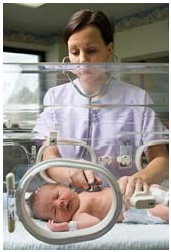What Is A Fetoscopy and What Are The Risks?
Fetoscopy is a procedure which is performed to allow your health care provider to see your baby while it is still in your uterus with the aid of a thin flexible instrument called a fetoscope, The fetoscope is inserted into the uterus through a thin incision in the stomach wall. This is all carried out with the aid of an ultrasound – which allows the health care provider to ‘see’ where the instrument is, so that they do not harm the baby. If you are going to have a Fetoscopy carried out, then it is usually performed around the 18th week of a pregnancy. The reasons why this is done at this time is because by the 18th week the placenta and your baby would have developed sufficiently to allow your health care provider to diagnose any potential problems.Why is a fetoscopy performed?
The most common reasons why a fetoscopy may be required are.- Evaluate the fetus for birth defects, such as spina bifida as well as other defects which can only be confirmed by a Fetoscopy
- To collect samples of blood from the umbilical cord. These samples can then be tested further at a lab for diseases such as hemophilia or sickle cell anemia
- Collect samples of skin tissue from your baby. The tissue can be tested for some inherited diseases
Preparing for a fetoscopy
In preperation for a fetoscopy you may be asked not to eat or drink for 8 hours before the procedure. You may also be given antibiotics before the procedure to prevent any chance of an infection. Your health care provider will also ask you sign a form which will state that you are aware of the risks of undergoing a fetoscopy. Be sure to speak with your health care provider, ask him all the questions you can think of and if you do not understand anything, be sure to let him/her know.How is a fetoscopy performed?
The entire procedure can take between 1-2 hours and this is the procedure you can expect to undergo.- Your doctor will check the fetal heart rate
- You may be given medication such as meperidine (Demerol) to prevent your baby from moving around a lot
- You will be required to remove your clothes around your waist down – this will then be covered with a paper or cloth, leaving your stomach exposed
- You will then lie on your back, but your upper body will be slightly raised so that your stomach muscles can relax
- Your lower stomach will be cleaned and you will be given a local anesthetic in the area where the incision will be made
- The doctor will determine the position of the fetus and the placenta using ultrasound
- With the ultrasound picture as a guide, your health care provider will then determine the best place to make a small incision in your stomach and uterus to insert the fetoscope directly into the uterus
- Your health care provider will then examine your baby, and may choose to take samples which can be assessed in a lab
After the fetoscopy
- Once the fetoscope is removed, the incision is closed with stitches, and a bandage is applied.
- An ultrasound will be performed to ensure that your baby is safe and that the amniotic fluid levels are satisfactory
- The ultrasound will be repeated the day after the fetoscopy to check your baby and the placenta
What are the risks invoilved?
- Miscarriage, as high as 12%.
- Excessive bleeding, infection, or excessive leakage of the amniotic fluid
- Preterm rupture of the membranes which may require early delivery of your baby
- Mixing your blood with your babys blood
- Moderate or severe abdominal pain or cramping
- Chills or a fever
- Dizziness
- Fluid or blood leaking from your vagina or from the cut in your belly
Fetoscopy


